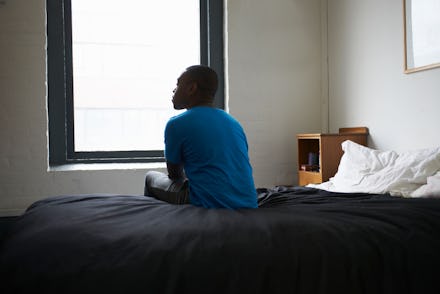Will our fear of going outside last well beyond the pandemic?

Social distancing makes leaving the house a new kind of obstacle course. Every time I exit my door, I immediately start to calculate the distance between myself and all other humans in my line of vision. I plot my dog walks for maximum avoidance. I assume that myself and all other people are infected with coronavirus and behave accordingly. At the same time, my home is now a spotless fortress of peace. It’s the cozy nest where I don’t have to worry. For better or worse, a lot of us are more comfortable in our homes than anywhere else, and some people are scared that the COVID-19 crisis might make them agoraphobic. Should we actually be afraid that we may never want to leave our houses again?
First of all, agoraphobia is a word we use a lot casually but that has a really specific clinical meaning. We have a tendency, for example, to call people who are simply homebodies “agoraphobic,” but that’s not really what it means. “Agoraphobia is a fear of going anywhere where you can’t escape or find help,” says Aimee Daramus, a Chicago-based psychotherapist. “Not being able to leave the house at all is a severe form of the disorder.”
Agoraphobia, then, doesn’t mean that you don’t want to leave the house, it means that you have a mental illness that makes the idea of being stuck in potentially unsafe places terrifying to the degree that you avoid places, generally. It would be like walking into moving traffic for the rest of us.
And because agoraphobia, clinically speaking, is an anxiety disorder, and it can be a diagnosis that stands alone, but often it doesn’t. So it generally doesn’t spontaneously occur in someone who is physically and mentally healthy unless there’s a trauma. And while this pandemic is traumatic for many people, “becoming agoraphobic is not typically a thing,” Stefani Goerlich, a Detroit-based psychotherapist, tells me.
“Most phobias are rooted in some traumatic precipitating event that is not processed in a healthy way, resulting in a lingering fear.” She goes on to say that feeling scared or unsafe to go outside right now is not irrational, i.e., it’s not mentally unhealthy, and that it probably won’t last for most people. “The vast majority of people are not in danger of developing agoraphobia,” Goerlich says.
“Becoming agoraphobic usually happens in people who already have a severe anxiety disorder, like panic disorder or generalized anxiety disorder,” says Daramus. “Sometimes, agoraphobia happens in people with chronic illnesses who are afraid of becoming ill when they’re out in public.” So, right now, people who are already managing mental illness are more at risk of their conditions worsening — but that definitely doesn’t need to happen. For people with anxiety or depression, getting or staying in therapy and continuing with a course of meds they might be on it crucial.
To those who aren’t already dealing with an anxiety disorder, here’s some advice from the pros to help ease your fears about becoming a permanent home body. Even though stay-at-home isn’t lifting quite yet, now is a good time to start planning for re-entry. “Reframing the public health guides we’ve been given into creative visualizations can help us maintain perspective and avoid catastrophizing an already stressful situation,” says Goerlich. You can think now about how to feel safe later by planning out how you’re going to go about it.
Be honest and specific with yourself about your fears so that they don’t feel unmanageable, Daramus suggests. If you feel fearful about, say, going back to work and being in close quarters with others, talk to your boss or HR about setting up a system that makes you feel safe. Some companies will be amenable — or might even prefer — if their employees trickle in slowly as opposed to all at once.
Talk to a coach or a therapist now about other ways you can prepare. Re-entry doesn’t have to be dreaded. While it might be challenging, you could try to think of it as a fun creative project. “It might mean investing in a few pairs of vintage kid gloves or fancy designer face masks and starting a new trend in your social circle,” she says. Plague chic, anyone? I’ll take any ridiculous distraction.